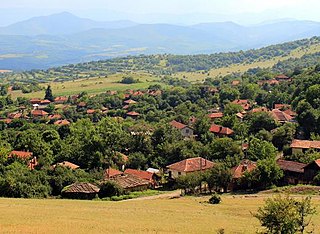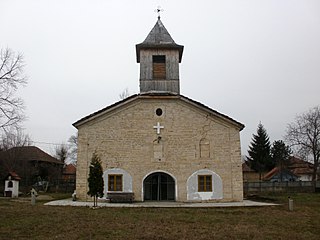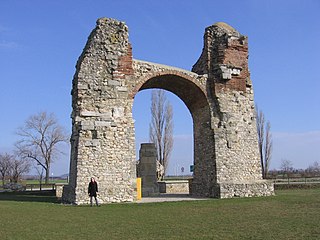
Vidin is a port city on the southern bank of the Danube in north-western Bulgaria. It is close to the borders with Romania and Serbia, and is also the administrative centre of Vidin Province, as well as of the Metropolitan of Vidin.

Silistra is a town in Northeastern Bulgaria. The town lies on the southern bank of the lower Danube river, and is also the part of the Romanian border where it stops following the Danube. Silistra is the administrative center of the Silistra Province and one of the important towns of the historical region of Dobruja.

Tulcea is a city in Northern Dobruja, Romania. It is the administrative center of Tulcea County, and had a population of 65,624 as of 2021. One village, Tudor Vladimirescu, is administered by the city. It is one of six Romanian county seats lying on the Danube river.

Vidin Province is the northwesternmost province of Bulgaria. It borders Serbia to the west and Romania to the northeast. Its administrative centre is the city of Vidin on the Danube river. The area is divided into 11 municipalities. As of 2023, the province had a population of 72,754.

Montana Province is a province in northwestern Bulgaria, bordering Serbia in the southwest and Romania in the north. It spreads its area between the Danube river and the Balkan Mountains. As of February 2011, the province had a population of 148,098, on territory of 3,635.5 km2 (1,403.7 sq mi). It was named after its administrative centre the city of Montana.

Pleven Province is a province located in central northern Bulgaria, bordering the Danube river, Romania and the Bulgarian provinces of Vratsa, Veliko Tarnovo and Lovech. It is divided into 11 subdivisions, called municipalities, that embrace a territory of 4,653.32 km2 (1,796.66 sq mi) with a population, as of February 2011, of 269 752 inhabitants. The province's capital is the city of Pleven.

Varna Province, formerly known as Varna okrug, is a province in eastern Bulgaria, one of the 28 Bulgarian provinces. It comprises 12 municipalities with a population of 494,216 as of April 2016. The province is named after its administrative centre, Varna.
Lom is a town in northwestern Bulgaria, part of Montana Province, situated on the right bank of the Danube, close to the estuary of the Lom River. It is the administrative centre of the eponymous Lom Municipality. The town is 162 km (101 mi) north of Sofia, 56 km (35 mi) southeast of Vidin, 50 km (31 mi) north of Montana, and 42 km (26 mi) west of Kozloduy. It is the second most important Bulgarian port on the Danube after Ruse.

Nikopol is a town in northern Bulgaria, the administrative center of Nikopol Municipality, part of Pleven Province, on the right bank of the Danube river, 4 kilometres downstream from the Danube’s confluence with the Osam river. It spreads at the foot of steep chalk cliffs along the Danube and up a narrow valley.
The Limes Germanicus, or 'Germanic Limes', is the name given in modern times to a line of frontier fortifications that bounded the ancient Roman provinces of Germania Inferior, Germania Superior and Raetia, dividing the Roman Empire and the unsubdued Germanic tribes from the years 83 to about 260 AD. The frontier used either a natural boundary such as a river or typically an earth bank and ditch with a wooden palisade and watchtowers at intervals, and a system of linked forts was built behind them.

The Moesian Limes is the modern term given to a linked series of Roman forts on the northern frontier of the Roman province of Moesia along the Danube between the Black Sea shore and Pannonia and dating from the 1st century AD. It was the eastern section of the so-called Danubian Limes and protected the Roman provinces of Upper and Lower Moesia south of the river. The eastern section is often called the limes Scythiae minoris as it was located in the late Roman province of Scythia Minor.
The Tsibritsa is a river in the western Danubian Plain of northern Bulgaria and a right tributary of the Danube. The river originates in the Shiroka Planina area of the Fore-Balkan Mountains near the Serbian border and flows in a northeast direction diagonally through Montana Province. East of the village of Dolni Tsibar in Valchedram municipality, it flows into the Danube.

Vrav is a village in northwestern Bulgaria, part of Bregovo municipality, Vidin Province. Located on the right bank of the Danube at the place where the Timok River empties into it, Vrav is the northernmost populated place in Bulgaria and the first Bulgarian port along the Danube's course. The village has a Romanian population and lies 30 kilometres from the provincial capital Vidin and 12 kilometres from Bregovo.

The Devil's Dykes, also known as the Csörsz árka or the Limes Sarmatiae, are several lines of Roman fortifications built mostly during the reign of Constantine the Great (306–337), stretching between today's Hungary, Romania and Serbia.
Scaidava was a Dacian town between Iatrus and Trimammium (Ablanovo) near the village of Batin, Bulgaria.

Novo Selo Municipality is a frontier municipality (obshtina) in Vidin Province, Northwestern Bulgaria, located along the right bank of Danube river in the Danubian Plain. It is named after its administrative centre - the village of Novo Selo. The area borders on Romania beyond the Danube to the north.
The Danubian Limes, or Danube Limes, refers to the Roman military frontier or limes which lies along the River Danube in the present-day German state of Bavaria, in Austria, Slovakia, Hungary, Croatia, Serbia, Bulgaria and Romania.

The Pannonian Limes is part of the old Roman fortified frontier known as the Danubian Limes that runs for approximately 420 km (260 mi) from the Roman camp of Klosterneuburg in the Vienna Basin in Austria to the castrum in Singidunum (Belgrade) in present-day Serbia. The garrisons of these camps protected the Pannonian provinces against attacks from the north from the time of Augustus (31 BC–14 AD) to the beginning of the 5th century. In places this section of the Roman limes also crossed the river into the territory of the barbarians (Barbaricum).

Dolni Rakovets is a village in western Bulgaria. It is located in Radomir Municipality, Pernik Province. The village is known for its long traditions in garlic production.














